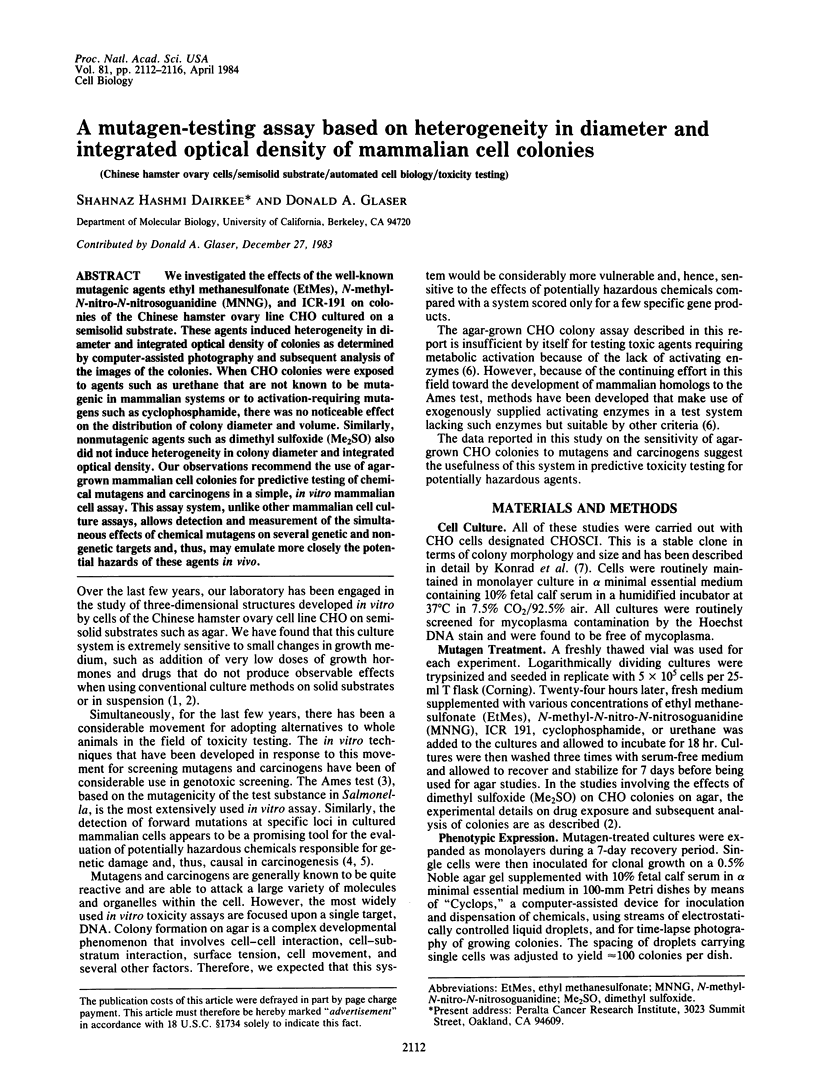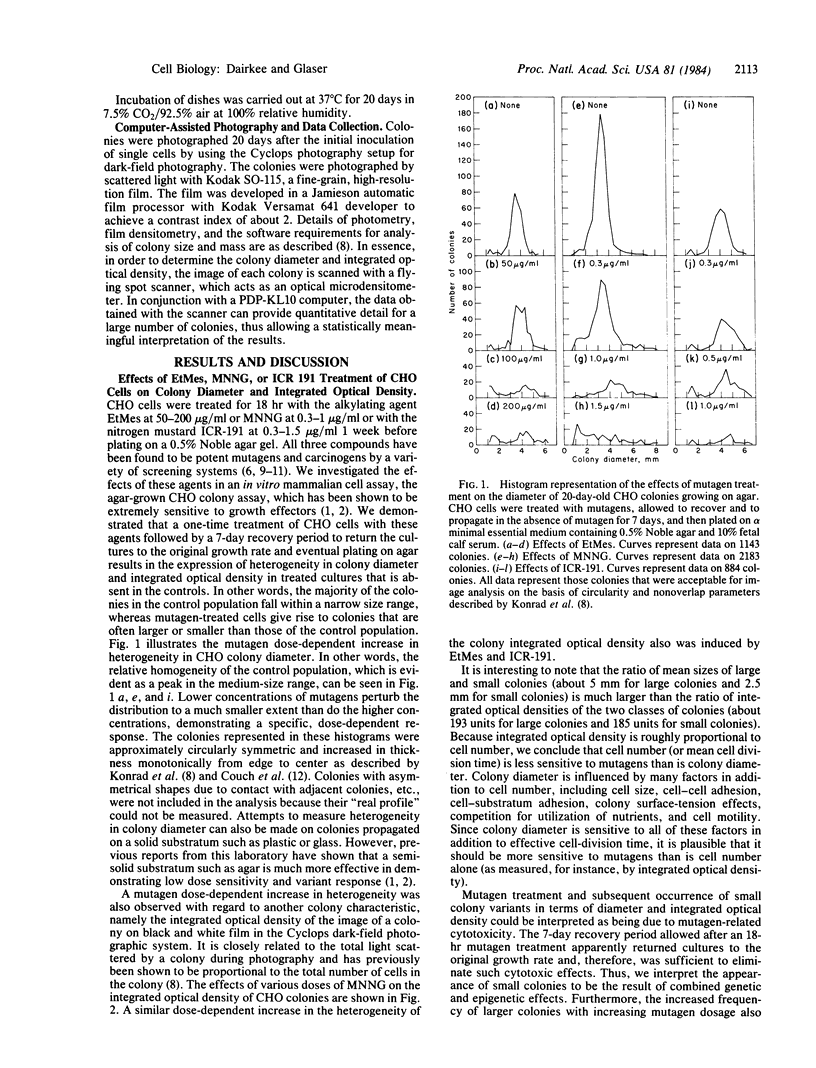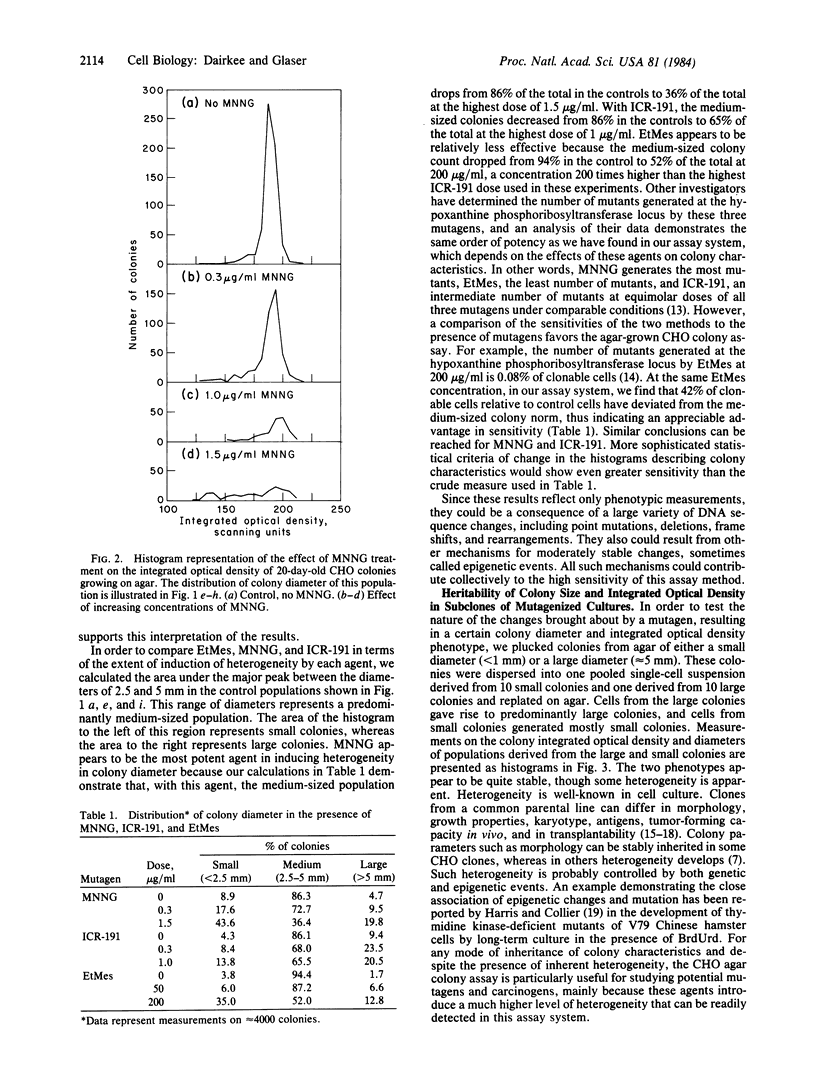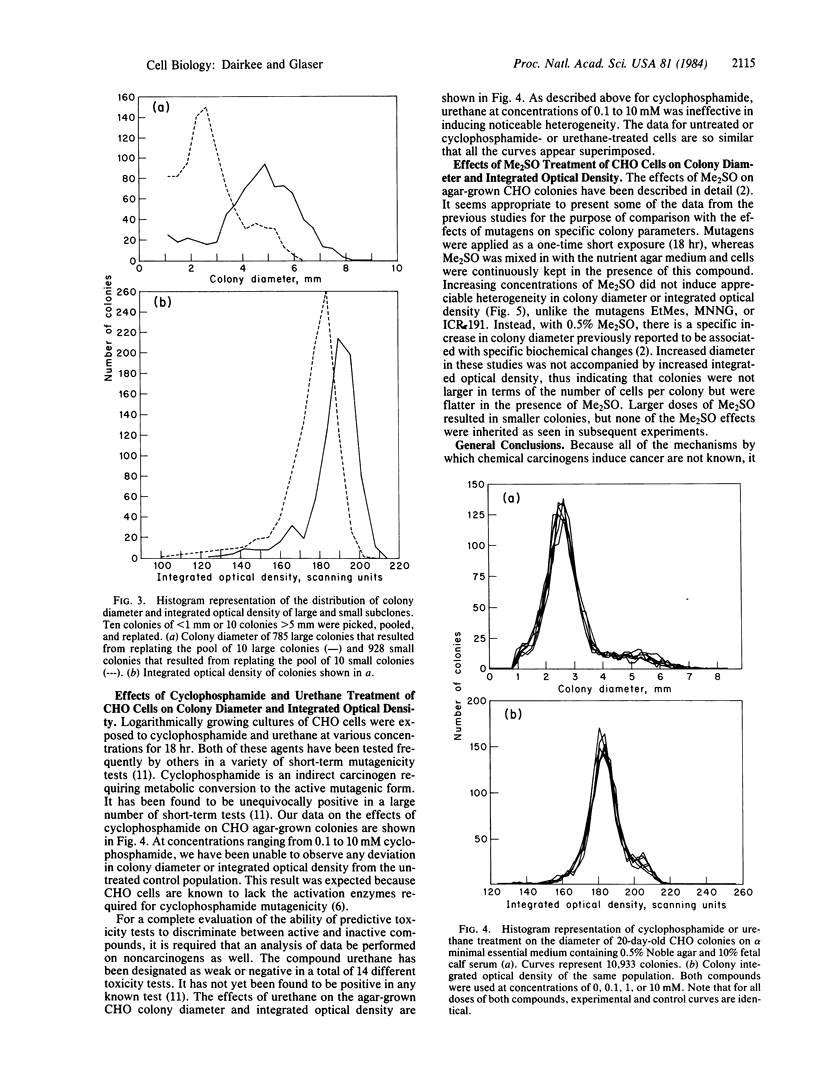Abstract
We investigated the effects of the well-known mutagenic agents ethyl methanesulfonate (EtMes), N-methyl-N-nitro-N-nitrosoguanidine (MNNG), and ICR-191 on colonies of the Chinese hamster ovary line CHO cultured on a semisolid substrate. These agents induced heterogeneity in diameter and integrated optical density of colonies as determined by computer-assisted photography and subsequent analysis of the images of the colonies. When CHO colonies were exposed to agents such as urethane that are not known to be mutagenic in mammalian systems or to activation-requiring mutagens such as cyclophosphamide, there was no noticeable effect on the distribution of colony diameter and volume. Similarly, nonmutagenic agents such as dimethyl sulfoxide (Me2SO) also did not induce heterogeneity in colony diameter and integrated optical density. Our observations recommend the use of agar-grown mammalian cell colonies for predictive testing of chemical mutagens and carcinogens in a simple, in vitro mammalian cell assay. This assay system, unlike other mammalian cell culture assays, allows detection and measurement of the simultaneous effects of chemical mutagens on several genetic and non-genetic targets and, thus, may emulate more closely the potential hazards of these agents in vivo.
Full text
PDF




Selected References
These references are in PubMed. This may not be the complete list of references from this article.
- Aidells B. D., Konrad M. W., Glaser D. A. Growth and morphology of colonies of Chinese hamster ovary cells growing on agar is affected by insulin. Proc Natl Acad Sci U S A. 1979 Apr;76(4):1863–1867. doi: 10.1073/pnas.76.4.1863. [DOI] [PMC free article] [PubMed] [Google Scholar]
- Ames B. N., Mccann J., Yamasaki E. Methods for detecting carcinogens and mutagens with the Salmonella/mammalian-microsome mutagenicity test. Mutat Res. 1975 Dec;31(6):347–364. doi: 10.1016/0165-1161(75)90046-1. [DOI] [PubMed] [Google Scholar]
- Dairkee S. H., Glaser D. A. Dimethyl sulfoxide affects colony morphology on agar and alters distribution of glycosaminoglycans and fibronectin. Proc Natl Acad Sci U S A. 1982 Nov;79(22):6927–6931. doi: 10.1073/pnas.79.22.6927. [DOI] [PMC free article] [PubMed] [Google Scholar]
- Dexter D. L., Kowalski H. M., Blazar B. A., Fligiel Z., Vogel R., Heppner G. H. Heterogeneity of tumor cells from a single mouse mammary tumor. Cancer Res. 1978 Oct;38(10):3174–3181. [PubMed] [Google Scholar]
- Harris M., Collier K. Phenotypic evolution of cells resistant to bromodeoxyuridine. Proc Natl Acad Sci U S A. 1980 Jul;77(7):4206–4210. doi: 10.1073/pnas.77.7.4206. [DOI] [PMC free article] [PubMed] [Google Scholar]
- Hsie A. W., Brimer P. A., Mitchell T. J., Gosslee D. G. The dose-response relationship for ethyl methanesulfonate-induced mutations at the hypoxanthine-guanine phosphoribosyl transferase locus in Chinese hamster ovary cells. Somatic Cell Genet. 1975 Jul;1(3):247–261. doi: 10.1007/BF01538449. [DOI] [PubMed] [Google Scholar]
- Hsie A. W., Brimer P. A., Mitchell T. J., Gosslee D. G. The dose-response relationship for ultraviolet-light-induced mutations at the hypoxanthine-guanine phosphoribosyltransferase locus in Chinese hamster ovary cells. Somatic Cell Genet. 1975 Oct;1(4):383–389. doi: 10.1007/BF01538669. [DOI] [PubMed] [Google Scholar]
- Konrad M. W., Couch J. L., Glaser D. A. A grey level frequency histogram representation of animal cell colonies seen by scattered light. Comput Biomed Res. 1980 Aug;13(4):333–349. doi: 10.1016/0010-4809(80)90026-9. [DOI] [PubMed] [Google Scholar]
- Konrad M. W., Storrie B., Glaser D. A., Thompson L. H. Clonal variation in colony morphology and growth of CHO cells cultured on agar. Cell. 1977 Feb;10(2):305–312. doi: 10.1016/0092-8674(77)90224-0. [DOI] [PubMed] [Google Scholar]
- O'Neill J. P., Couch D. B., Machanoff R., San Sebastian J. R., Brimer P. A., Hsie A. W. A quantitative assay of mutation induction at the hypoxanthine-guanine phosphoribosyl transferase locus in Chinese hamster ovary cells (CHO/HGPRT system): utilization with a variety of mutagenic agents. Mutat Res. 1977 Oct;45(1):103–109. doi: 10.1016/0027-5107(77)90048-3. [DOI] [PubMed] [Google Scholar]
- O'Neill J. P., Fuscoe J. C., Hsie A. W. Mutagenicity of heterocyclic nitrogen mustards (ICR compounds) in cultured mammalian cells. Cancer Res. 1978 Mar;38(3):506–509. [PubMed] [Google Scholar]
- O'Neill J. P., Hsie A. W. Chemical mutagenesis of mammalian cells can be quantified. Nature. 1977 Oct 27;269(5631):815–817. doi: 10.1038/269815a0. [DOI] [PubMed] [Google Scholar]
- O'Neill J. P., Hsie A. W. Phenotypic expression time of mutagen-induced 6-thioguanine resistance in Chinese hamster ovary cells (CHO/HGPRT system). Mutat Res. 1979 Jan;59(1):109–118. doi: 10.1016/0027-5107(79)90196-9. [DOI] [PubMed] [Google Scholar]
- Rubin H., Chu B. M., Arnstein P. Heritable variations in growth potential and morphology within a clone of Balb/3T3 cells and their relation to tumor formation. J Natl Cancer Inst. 1983 Aug;71(2):365–375. [PubMed] [Google Scholar]
- SANFORD K. K., WESTFALL B. B., CHU E. H., KUFF E. L., COVALESKY A. B., DUPREE L. T., HOBBS G. L., EARLE W. R. Alterations in morphology, arginase, and beta-glucuronidase within a clone of mouse tumor cells in vitro. J Natl Cancer Inst. 1961 May;26:1193–1219. [PubMed] [Google Scholar]
- Sanford K. K., Evans V. J. A quest for the mechanism of "spontaneous" malignant transformation in culture with associated advances in culture technology. J Natl Cancer Inst. 1982 Jun;68(6):895–913. [PubMed] [Google Scholar]


